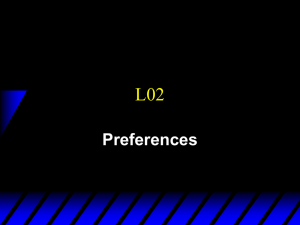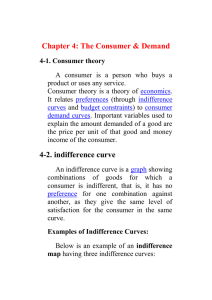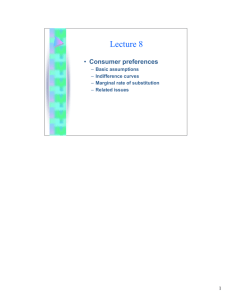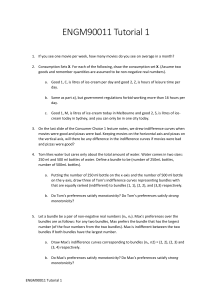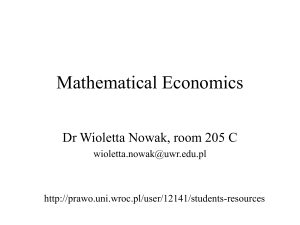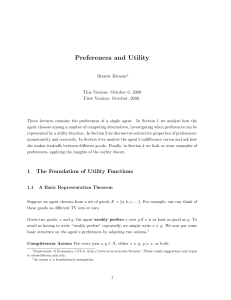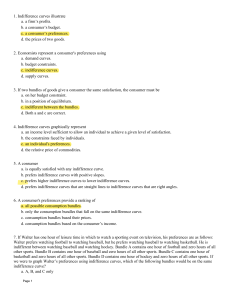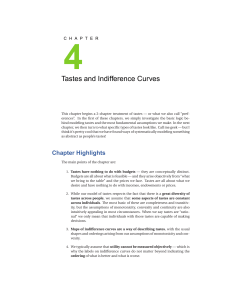x - Andrew.cmu.edu
advertisement
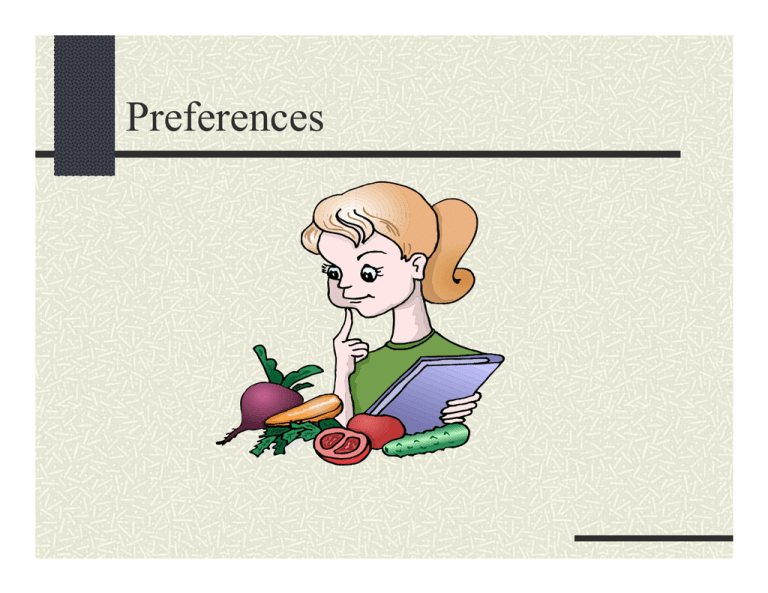
Preferences Preference Relation The consumer strictly prefers bundle X to bundle Y: ( x 1, x 2 ) f ( y 1, y 2 ) The consumer is indifferent between X and Y: ( x 1, x 2 ) ~ ( y 1, y 2 ) Weak Preference If ( x 1, x 2 ) f ( y 1, y 2 ) or ( x 1, x 2 ) ~ ( y 1, y 2 ) Then: ( x 1, x 2 ) ! ( y 1, y 2 ) How are the relations related? Q: What do these two relations imply? ( x 1, x 2 ) ! ( y 1, y 2 ) ( y 1, y 2 ) ! ( x 1, x 2 ) How are the relations related? A: The consumer is indifferent between X and Y: ( x 1, x 2 ) ~ ( y 1, y 2 ) Assumption I: Complete Preferences For any two bundles X and Y: X preferred to Y: ( x 1, x 2 ) ! ( y 1, y 2 ) Y preferred to X: ( y 1, y 2 ) ! ( x 1, x 2 ) Indifference: ( x 1, x 2 ) ~ ( y 1, y 2 ) Assumption II: Reflexive Any bundle X is at least as good as itself: ( x 1, x 2 ) ! ( x 1, x 2 ) Assumption III: Transitive If: ( x 1, x 2 ) ! ( y 1, y 2 ) And: ( y 1, y 2 ) ! ( z 1, z 2 ) Then: ( x 1, x 2 ) ! ( z 1 , z 2 ) Indifference curves Indifference curve x2 Weakly preferred set x2 x1 x1 Q: Can indifference curves cross? x2 X Z Y x1 Perfect substitutes x2 x1 Perfect complements x2 x1 Satiation x2 x2 x1 x1 Well-behaved preferences Let’s impose some extra assumptions to rule out less interesting situations Well-behaved preferences satisfy two properties: 1. Monotonicity 2. Convexity Monotonicity Consider two bundles: ( x 1, x 2 ), ( y 1, y 2 ) where Y has at least as much of both goods and more of one. Then: ( y 1, y 2 ) f ( x 1, x 2 ) Monotonicity implies that indifference curves have negative slopes Indifference curves have negative slopes x2 x2 x1 x1 Convexity Consider two bundles: ( x 1, x 2 ) ~ ( y 1, y 2 ) Convexity implies that, for 0 ≤ t ≤ 1 ( t x 1 + (1 − t ) y 1, t x 2 + (1 − t ) y 2 ) ! ( x 1, x 2) Convex preferences x2 y2 Z x2 y1 x1 x1 Non-convex preferences x2 y2 Z x2 y1 x1 x1 Marginal rate of substitution The MRS is the slope of the indifference curve at a point x2 ( x 1, x 2 ) x2 MRS=derivative of indifference curve x1 x1 Interpretation of MRS The MRS measures the rate at which the consumer is willing to substitute one good for the other. If good 2 is measured in dollars, the MRS measures the consumer’s willingness to pay for an extra unit of good 1.
